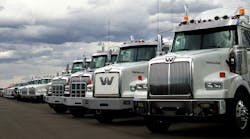The other day I came across an old sales poster — one I'd been saving for more than 10 years, basically because I am still amused at my smart — aleck comments and doodlings surrounding the 1991 WHITEGMC WIA64TES that the poster features.
It also brought to mind how not to present a used truck in an advertising piece, as well as how not to trade or accept a truck in trade. This truck is in such bad condition that making it presentable would be difficult even using today's digital photo wizardry.
The real issue with this particular vehicle is its “trade terms and conditions,” which are entirely in the control of the fleet. It's easy to quantify the value gained from “hard adds” like larger engines, transmissions and sleepers because they're market-driven.
But what about the simple value added by presenting a clean and DOT ready- to-work truck to a dealer? Enormous! Your fleet can have the biggest specs, but when the lease ends and you go to trade in a truck that is failing vis a vis trade terms and conditions, it could mean a $1,000, $5,000 or $10,000 deduction in value.
Back in the day when I dealt with fleets and the residual value of their equipment, each fleet seemed to have its own trade terms — and even those were moving targets, depending on where the fleet was in the buying process.
Unfortunately, there really is no official industry standard for trade terms and conditions. However, you can find an excellent generic outline for one on the Used Truck Assn.'s web site, www.uta.org. The UTA trade terms are the basis for The Truck Blue Book; I recommend using them as your guideline.
When fleets are putting equipment on the market they should adhere to the following trade terms and conditions:
-
Engine must operate at 85% of original manufactures rated horsepower;
-
Engine must not have excessive blow by;
-
The drivetrain must be roadworthy and free of defects;
-
Brakes must have 50% of linings remaining and pass DOT requirements;
-
Each tire must have 12/32” tread, with front tires on original casings and rears on original casing or first time recaps;
-
Frames must be straight and free of non-factory welds and cracks;
-
Body damage cannot exceed $500; Interior must not have tears, burns or permanent stains;
-
Windshield cannot have cracks, chips or dings;
-
Truck must be de-identified;
-
All batteries must be in sound working order and able to hold a charge;
-
Electrical systems must be working properly;
-
Air conditioning system must be capable of cooling the cab to 75 degrees;
-
Trucks must be made available for a third party warranty inspection if requested;
-
Titles must be free and clear of all liens and encumbrances;
-
Paid documentation of FHUT, form 2290, for the current year.
By following these guidelines, you could increase the trade-in value of your equipment by $3,500 or more. Dealers will have reduced expenses when preparing the trucks for resale and reduced inventory flooring costs; they'll also be able to pre-sell equipment before actually receiving the trades.
Some fleets have such solid reputations for exceeding trade terms that receiving dealers have only to mention that the equipment is available and it's sold. On the other hand, there are also fleets that are known for doing such a bad job of meeting trade terms that dealers are not interested in handling their equipment — even on a consignment basis.
Holding your equipment to higher trade term and condition standards will benefit your residual value, not to mention provide your drivers with safer, more comfortable work environments. In addition, you'll contribute to a better image for the industry as a whole. Ironically, that sales poster's tag line was: “Does it get any better than this?” Yes it does — and so can you.


